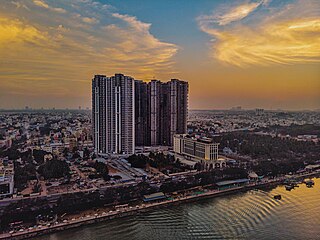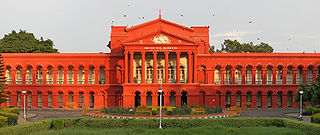
The Visvesvaraya Industrial and Technological Museum, (VITM), Bangalore, India, a constituent unit of the National Council of Science Museums (NCSM), Ministry of Culture, Government of India, was established in memory of Bharat Ratna Sir M Visvesvaraya. The building, with a built up area of 4,000 m2 (43,000 sq ft), was constructed in Cubbon Park. It houses various scientific experiments and engines, and was inaugurated by the first Prime Minister of India, Pandit Jawaharlal Nehru, on 14 July 1962. The first gallery set up at VITM, on the theme of 'Electricity', was opened to the public on 27 July 1965.

The Denison barb, Denison's barb, Miss Kerala, red-line torpedo barb, or roseline shark is an endangered species of cyprinid fish endemic to the fast-flowing hill streams and rivers of the Western Ghats in India. It is commonly seen in the aquarium trade; pet collection caused it to become endangered and is its single major threat.

The three spot gourami, also known as the opaline gourami, blue gourami, and gold gourami, is a species of fish native to southeastern Asia, but also introduced elsewhere. This gourami gets its name from the two spots along each side of its body in line with the eye, considered the third spot. This species is of minor commercial importance as a food fish in its native range and is also farmed. It is also popular in the aquarium trade.

Lalbagh Botanical Garden or shortened Lalbagh, is an old botanical garden in Bengaluru, India. First planned and laid out during the dalavaiship of Hyder Ali and later adorned with unique plant species by his son Tippu, it was later managed under numerous British Superintendents before Indian Independence. It was responsible for the introduction and propagation of numerous ornamental plants as well as those of economic value. It also served a social function as a park and recreational space, with a central glass house dating from 1890 which was used for flower shows. In modern times it hosts two flower shows coinciding with the week of Republic Day and Independence Day. As an urban green space along with Cubbon Park, it is also home to numerous wild species of birds and other wildlife. The garden also has a lake adjoining a large rock on which a watchtower had been constructed during the reign of Kempegowda II.

The paradise fish, paradise-fish, paradisefish, or paradise gourami is a species of gourami found in most types of fresh water in East Asia, ranging from the Korean Peninsula to northern Vietnam. This species can reach a standard length of 6.7 cm (2.6 in), though most are only about 5.5 cm (2.2 in). Paradise gouramis were one of the first ornamental fish available to western aquarium keepers, having been imported 1869 to France by the French aquarium fish importer Pierre Carbonnier in Paris. The paradise fish is one of the more aggressive members of its family. It is more aggressive than the three spot gourami, yet less pugnacious in nature than the less commonly kept combtail.

The dwarf gourami is a species of gourami native to South Asia.

Taman Mini "Indonesia Indah" is a culture-based recreational area located in East Jakarta, Indonesia. Since April 2021, it is operated by the Government of Indonesia through the Ministry of State Secretariat; it was formerly operated by Yayasan Harapan Kita, a foundation established by Siti Hartinah, the first lady during most of the New Order and wife of Suharto, and still run by Suharto's descendants since his death. It has an area of about 100 hectares.

Cubbon Park, officially known as Sri Chamarajendra Park, is a landmark 'lung' area of Bengaluru city, located within the heart of the city in the Central Administrative Area. Originally created in 1870, when Major General Richard Sankey was the then British Chief Engineer of Mysore state, it covered an area of 100 acres (0.40 km2) and subsequent expansion has taken place and the area reported now is about 300 acres (1.2 km2). It has a rich recorded history of abundant flora and fauna plantations coupled with numerous impressive and aesthetically located buildings and statues of famous personages, in its precincts.

The croaking gourami is a species of small freshwater labyrinth fish of the gourami family. They are native to still waters in Southeast Asia and are distributed worldwide via the aquarium trade. Croaking gouramis are capable of producing a "croaking" noise using their pectoral fins.

The rummy-nose tetra is a species of tropical freshwater characin fish originating in South America, popular among fishkeepers as an aquarium fish. One of many small tetras belonging to the same genus, it is on average 5 cm (2 in) long when fully grown, and is a long established favourite among tropical fishkeepers. The fish is one of several very similar species including Hemigrammus bleheri, and Petitella georgiae, and it is possible that more recently collected specimens available in the aquarium trade are members of one or other of these similar species. The common name applied to most of these fishes is "rummy-nose tetra", though other common names are in circulation.

Taraporewala Aquarium or Taraporevala Aquarium is India's oldest aquarium and one of the city's main attractions. It hosts marine and freshwater fish. The aquarium is located on Marine Drive in Mumbai..

The snakeskin gourami is a species of gourami native to Southeast Asia.

A freshwater aquarium is a receptacle that holds one or more freshwater aquatic organisms for decorative, pet-keeping, or research purposes. Modern aquariums are most often made from transparent glass or acrylic glass. Typical inhabitants include fish, plants, amphibians, and invertebrates, such as snails and crustaceans.
George Sprague Myers was an American ichthyologist who spent most of his career at Stanford University. He served as the editor of Stanford Ichthyological Bulletin as well as president of the American Society of Ichthyologists and Herpetologists. Myers was also head of the Division of Fishes at the United States National Museum, and held a position as an ichthyologist for the United States Fish and Wildlife Service. He was also an advisor in fisheries and ichthyology to the Brazilian Government.

Bangalore City Railway Station, officially Krantivira Sangolli Rayanna , also known as Bengaluru City railway station (2014–2016), is the main railway station serving the city of Bangalore, Karnataka, India. It is the sixth busiest inter-city railway station in South India after Chennai Central, Chennai Egmore, Tambaram railway station, Chennai Beach railway station, Moore Market Complex railway station It is the busiest railway station in South Western Railway zone of Indian Railways.

Lakes in Bangalore, Karnataka are numerous, and there are no rivers close by. Most lakes in the Bangalore region were constructed in the sixteenth century by damming the natural valley systems by constructing bunds.

The River Safari is a river-themed zoo and aquarium located in Singapore. It is built over 12 hectares and nestled between its two counterparts, the Singapore Zoo and the Night Safari, Singapore. It is the first of its kind in Asia and features freshwater exhibits and a river boat ride as its main highlights. The safari was built at a cost of S$160m, with an expected visitor rate of 820,000 people yearly.

Project Piaba is a fishery initiative located on the Rio Negro tributary of the Amazon River. The program both promotes and researches sustainable aquarium pet fish collection and its impact on the environment. The name of the project comes from the Brazilian Portuguese word, piaba, which means "little fish", referring specifically to the cardinal tetra. Project Piaba is an ongoing project with annual research expeditions to the Rio Negro region. Because of the sustainable nature of the project, its slogan is "Buy a Fish, Save a Tree!"

Attara Kacheri in Bangalore, India is the seat of the principal bench of the Karnataka High Court, the highest judicial authority in the state of Karnataka. It is a neoclassical red-painted stone and brick building in Cubbon Park, located on Dr. B. R. Ambedkar Road opposite the Vidhana Soudha. It previously housed the secretariat of the princely state of Mysore and then that of independent India's Mysore State.


















